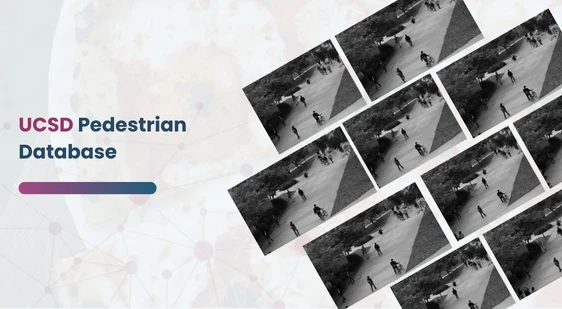UCSD Pedestrian Database
Home » Dataset Download » UCSD Pedestrian Database
UCSD Pedestrian Database
Datasets
UCSD Pedestrian Database
File
UCSD Pedestrian Database
Use Case
UCSD Pedestrian Database
Description
Explore the UCSD Pedestrian Database, a comprehensive grayscale video dataset for pedestrian detection, crowd analysis, and scene segmentation.

Description:
The UCSD Pedestrian Database is a benchmark dataset primarily used for computer vision research, particularly in pedestrian detection, crowd analysis, and video segmentation tasks. Originally featured in the paper “Modeling, Clustering, and Segmenting Video with Mixtures of Dynamic Textures,” this dataset plays a crucial role in advancing algorithms related to video-based object detection and scene understanding.
Dataset Description
The UCSD Pedestrian Dataset consists of grayscale video footage captured along walkways at the University of California, San Diego (UCSD). The videos are taken from a stationary camera placed at various viewpoints around the campus, ensuring diverse perspectives for researchers to work with. Each video clip contains pedestrian movements recorded under natural conditions, providing an ideal environment for testing pedestrian detection and behavior modeling techniques.
Download Dataset
Data Format and Structure
The videos are record at a resolution of 238×158 pixels, with a frame rate of 10 frames per second (fps), offering a moderate-quality view of pedestrian movement while keeping file sizes manageable. All videos are in 8-bit grayscale format, minimizing color distractions and focusing on movement patterns.
The dataset is organize into directories based on different scene locations. Each directory (e.g., vidX, where X is a specific scene identifier such as “vidf”) contains multiple short video clips of pedestrians. Each video clip consists of 200 frames, store as individual .png image files for easier frame-by-frame analysis. The naming convention for each clip follows the format vidfXY ZZZ.y, where Y and ZZZ are numerical identifiers for the video and frame numbers, respectively.
Key Features
- Grayscale Videos: Simplifies the task of detecting moving objects by eliminating color information, making it more suitable for testing motion-detection algorithms.
- Stationary Camera: Ensures that only the pedestrians are moving, enabling a focus on human behavior without other environmental distractions.
- Multiple Viewpoints: Although the initial release features only one scene, future expansions of the dataset promise diverse perspectives to enhance the dataset’s robustness.
- Clip-Base Organization: The videos are broken into 200-frame clips, allowing for manageable chunks of data that can be processed or analyze individually.
- Use in Dynamic Texture Modeling: This dataset has been historically important for studies in dynamic texture modeling, where pedestrian movement is treat as a time-varying texture for analysis.
Applications
The UCSD Pedestrian Database is widely use in:
- Pedestrian Detection: Developing algorithms that accurately identify pedestrians in video sequences.
- Crowd Behavior Analysis: Studying the collective movement and interactions of pedestrians in public spaces.
- Scene Segmentation: Separating pedestrians from the background to improve real-time video processing applications.
- Video Compression: Testing video encoding methods that can maintain quality while reducing file size.
- Surveillance Systems: Enhancing the accuracy of automate video surveillance for identifying unusual or suspicious pedestrian activity.
This dataset is sourced from Kaggle.
Contact Us

Quality Data Creation

Guaranteed TAT

ISO 9001:2015, ISO/IEC 27001:2013 Certified

HIPAA Compliance

GDPR Compliance

Compliance and Security
Let's Discuss your Data collection Requirement With Us
To get a detailed estimation of requirements please reach us.
